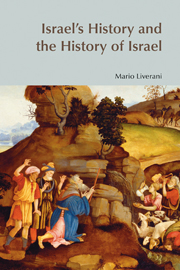Book contents
- Frontmatter
- Dedication
- Contents
- List of Tables and Illustrations
- Foreword
- Abbreviations
- IMPRINTING
- Part I A NORMAL HISTORY
- Chapter 2 THE TRANSITION (TWELFTH CENTURY)
- Chapter 3 THE NEW SOCIETY (c. 1150–1050)
- Chapter 4 THE FORMATIVE PROCESS (c. 1050–930)
- Chapter 5 THE KINGDOM OF ISRAEL (c. 930–740)
- Chapter 6 THE KINGDOM OF JUDAH (c. 930–720)
- Chapter 7 THE IMPACT OF THE ASSYRIAN EMPIRE (c. 740–640)
- Chapter 8 PAUSE BETWEEN TWO EMPIRES (c. 640–610)
- Chapter 9 THE IMPACT OF THE BABYLONIAN EMPIRE (c. 610–585)
- INTERMEZZO
- Part II AN INVENTED HISTORY
- EPILOGUE
- Bibliography
- Index of References
- Index of Names of Persons and Deities
- Index of Placenames
Chapter 9 - THE IMPACT OF THE BABYLONIAN EMPIRE (c. 610–585)
from Part I - A NORMAL HISTORY
- Frontmatter
- Dedication
- Contents
- List of Tables and Illustrations
- Foreword
- Abbreviations
- IMPRINTING
- Part I A NORMAL HISTORY
- Chapter 2 THE TRANSITION (TWELFTH CENTURY)
- Chapter 3 THE NEW SOCIETY (c. 1150–1050)
- Chapter 4 THE FORMATIVE PROCESS (c. 1050–930)
- Chapter 5 THE KINGDOM OF ISRAEL (c. 930–740)
- Chapter 6 THE KINGDOM OF JUDAH (c. 930–720)
- Chapter 7 THE IMPACT OF THE ASSYRIAN EMPIRE (c. 740–640)
- Chapter 8 PAUSE BETWEEN TWO EMPIRES (c. 640–610)
- Chapter 9 THE IMPACT OF THE BABYLONIAN EMPIRE (c. 610–585)
- INTERMEZZO
- Part II AN INVENTED HISTORY
- EPILOGUE
- Bibliography
- Index of References
- Index of Names of Persons and Deities
- Index of Placenames
Summary
Nebuchadrezzar and the Imperial Reconquest
After defeating the Egyptians in 609 at Carchemish and Hamath, Nebuchadrezzar persevered with annual campaigns to subjugate to the new Neo-Babylonian empire all the territories of Syria Palestine that had previously submitted to Assyria, and even those that until then had been independent. The Babylonian Chronicle presents the submission as initially spontaneous and bloodless: ‘All the kings of Hatti (= Syria-Palestine) came into his presence and he received their vast tribute’ (ABC, 100.17). However, a prophetic source describes the terrifying effect that the new ‘scourge of God’ had on the local population:
For I am rousing the Chaldeans,
that fierce and impetuous nation,
who march through the breadth of the earth
to seize dwellings not their own.
Dread and fearsome are they;
their justice and dignity proceed from themselves.
Their horses are swifter than leopards,
more menacing than wolves at dusk;
their horses charge.
Their horsemen come from far away;
they fly like an eagle swift to devour.
They all come for violence,
with faces pressing forward;
they gather captives like sand.
At kings they scoff,
and of rulers they make sport.
They laugh at every fortress,
and heap up earth to take it
(Hab. 1.6–10).The current depiction of the Babylonians as less ‘fierce’ than the Assyrians depends on their respective communicative strategies. The Assyrian kings had practised (in their celebrative inscriptions, as well as palace reliefs) a real ‘strategy of terror’, while the Chaldeans tried to promote an image of benevolence and devotion to the care of the temples, even omitting military deeds from their celebrative inscriptions.
- Type
- Chapter
- Information
- Israel's History and the History of Israel , pp. 183 - 200Publisher: Acumen PublishingPrint publication year: 2005



